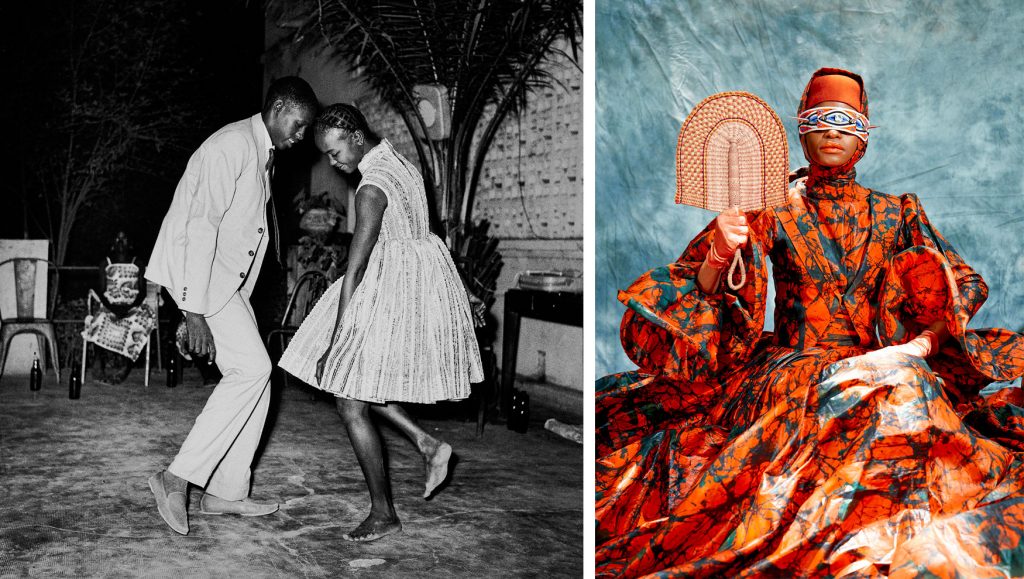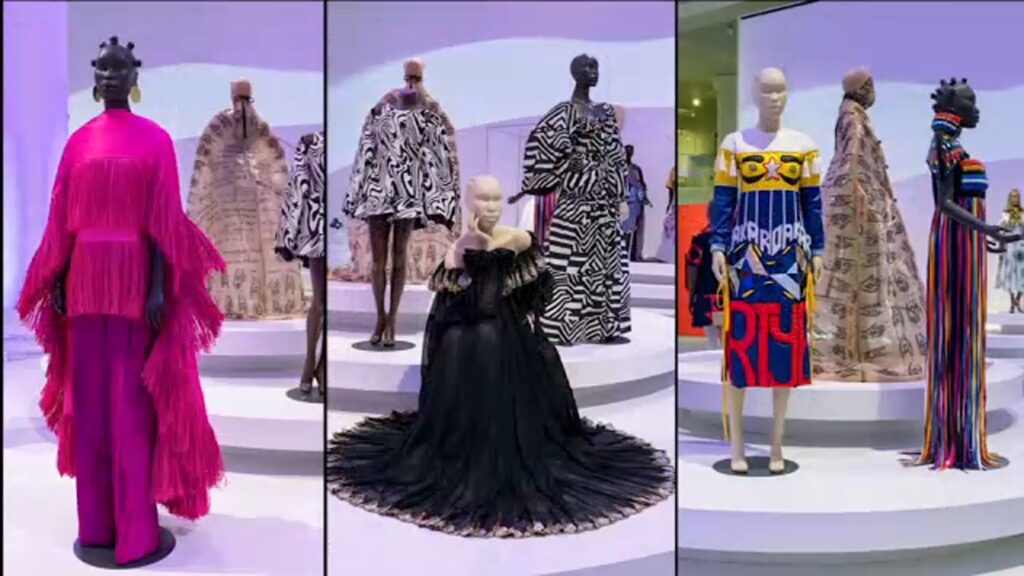- Over 180 works of fashion from 40 designers drawn from across 20 countries in Africa are currently exhibiting in Brooklyn, New York.
- The Africa Fashion is celebrating works by iconic designers and artists from Nigerian Shade Thomas-Fahn, Ghana’s Kofi Ansah, South African Thebe Magugu and Djibouti’s Gouled Ahmed.
- South Africa, Nigeria, Ghana, Morocco and Kenya boast of a dynamic local fashion scene setting trends in African fashion.
Africa’s dynamic and lucrative fashion industry has taken center stage at the Brooklyn Museum in New York in the ongoing ‘Africa Fashion’ display that ends on Sunday, 22nd October 2023.
The landmark event has been hailed as the largest presentation of African fashion. It involves more than 180 works from over 40 designers drawn from 20 countries in the continent. Africa Fashion celebrates works by iconic designers and artists. Some of the industry’s icons are Nigerian Shade Thomas-Fahn, Ghana’s Kofi Ansah to South African Thebe Magugu and Djibouti’s Gouled Ahmed.
Making its debut in North America, the expo has been featuring immersive displays of haute couture, and ready-to-wear apparel. Catwalk footage, textiles, jewelry, photographs, literature, sketches, music, film and visual arts are also featuring. It has been named as Africa’s fashion revolution. It starts with a timeline of each African country and their journey to independence in the 20th century, between the 1950s and 1994. This is the period that brought the African Cultural Renaissance. Current styles created by new age designers are also on display.
African countries have been leveraging preferential trade agreements, such as the African Growth and Opportunity Act (AGOA) and even the African Continental Free Trade Area (AfCFTA), to access the US market. The continent’s proximity to major markets coupled with low labour costs is enhancing Africa’s evolution as a leading exporter of apparels. For instance, Kenya, Ethiopia, Lesotho, Madagascar are examples of African nations with a global apparel sector that is generating good revenues.
Fueled by digitalization, urbanization and Africa’s growing middle class, the domestic fashion market is equally impressive. From designers, entrepreneurs, influencers and fashion-conscious consumers shaping the trends, the industry is booming. African designers are increasingly showcasing in major fashion capitals like New York, Paris, and Milan. What’s more, they are getting opportunities to dress international artists. Already, South Africa, Nigeria, Ghana, Morocco and Kenya are boasting of a dynamic local fashion scene setting trends in African fashion.

Read also: Africa’s fashion safari pushing new frontiers
State of Africa’s Fashion Market
According to Statista, Africa’s fashion market revenue is forecast to reach $6.40 billion by end of 2023. Data shows the sector will grow at an annual growth rate of 12.14 per cent between 2023 and 2027. This will result in a market volume of $10.12 billion by 2027.
However, the current market volume which is estimated to stand at $265.50 billion draws most of its revenue in China. With a user penetration of 20.5 per cent in 2023 and expected to hit 28.3 per cent by 2027, the future of the market looks promising. The industry projects that the average revenue per user will amount to $24.58 in 2027. Overall, the number of fashion market users is expected to amount to 393.6 million users by the same time.
Africa’s youthful population savvy with the use of digital platforms has seen African designers gain international recognition. An increasing number of designers are using Instagram and Facebook platforms to connect with a wider market across Africa. At the same time, sustainable or eco-fashion is taking centre stage as industries move to tackle climate change.

Photo/Yen News.
Read also: C-19 Pandemic: The fashion industry’s black swan event
The African fashion landscape
Nigeria and Egypt are trailblazers in this vibrant fashion sector. These markets have taken Africa’s fashion landscape by storm producing new apparel, footwear and accessories, according to data by Statista. Collectively, the two nations are set to rake in a whopping 2.5 billion in revenue by the close of 2023.
The Nigerian fashion market is estimated to expand to $1.31 billion by 2023. Estimates show the market is set to record an annual growth rate of 10.03 per cent between 2023 and 2027. Projections show that Nigeria will have estimated fashion market volume of $1.92 billion by 2027. Furthermore, Nigeria is projected to boast a growing user base of approximately 83.8 million people by 2027. In Nigeria, the user penetration rate is currently at 24.4 per cent and is set to soar to 34.1 per cent by 2027 with the average revenue per user hitting $24.
Similarly, Egypt’s fashion market is on a growth trajectory, forecast to reach $1.28 billion in 2023. With the lucrative industry growing at an annual growth rate of 16.40 per cent, the market will attain a market volume of $2.35 billion by 2027. The country’s user penetration currently stands at 33.3 per cent and is projected to rise by 47.1 per cent by 2027. Market estimates show that the expected revenue per user will reach $34.19.

Photo/Egypt Today
What’s more, Egypt’s vibrant cotton production industry boasts of trade contracts with over 30 countries for the key input in fashion. The country is also as a top tourist destination, providing s steady stream of buyers for its local fashion.
Further, the country’s population of over 100 million and a youthful demographic is driving demand in the fashion industry. The youth are more fashion–conscious and spend money on fashion items. Overall, Nigeria and Egypt are poised to become the continent’s powerhouses, additionally driven by their online culture and vibrant fashion scenes.
Read also: Renaissance: African art investments soar to new heights in 2022
Role of e-commerce and startups in the market
The transformative role of e-commerce and digital innovation in driving the growth of the African fashion industry is undeniable. E-commerce is becoming a necessity for players in the fashion value chains.
Digital innovation is creating new opportunities for African fashion creatives, enabling them to reach global buyers. This is according to a recent report by Ananse, an e-commerce platform that serves as a vital link connecting African designers with local and international consumers in collaboration with the research firm, Botho Emerging Markets Group, the MasterCard Foundation, and the African Development Bank’s Fashionomics initiative.
The report titled “Unleashing the Commercial Potential of African Creatives through Digital Technology;” underscores the importance of user-friendly digital platforms tailored to micro, small, and medium-sized enterprises, facilitating their access to global markets. Some of the e-commerce platforms dealing in fashion include: Soko, Afrikrea, Tradsquare, MEST Incubator, and Fashpa.

Photo/Backlink Providers
According to a report by RationalStat, South Africa’s e-commerce market has market value of $6.2 billion. It is expected to grow at over 14.8 per cent annually to $16.3 billion by 2030. Top online ecommerce platforms in the country include: Takealot which raked in revenues worth $556.6 million in 2022, Superbalist ($263.8 million), Woolworths ($145.3 million), Shein and Truworths.
The country’s e-commerce fashion market is predicted to reach $858.4 million by 2023. With a projected annual growth rate of 14.1 percent, it will post $1452.9 million market volume by 2027 according to e-commerce data base.
In West Africa, Nigeria’s e-commerce market of apparel, footwear, bags and accessories will reach $1254.4 million by end of 2023. It will register a market volume of $1830.9 million by 2027. The success of e-commerce fashion is largely attributable to expanding internet culture among Nigerians. Nigeria had 222.5 million telephone customers as of 2022, according to estimates by the country’s National Bureau of Statistics (NBS).
In neighbouring Ghana, the fashion e-commerce market will reach $132 million by the end of this year. It has a projected 14.4 per cent annual growth which could result in a market volume of $226.3 million by 2027.
In the North, the Moroccan fashion ecommerce market is forecast to reach $292.1 million by the close of 2023. Morocco’s fashion sector has an expected annual growth rate of 11.9 per cent, resulting in a projected market volume of $458.4 by 2027.
The fashion e-commerce market in Kenya, East Africa’s powerhouse, is forecast to reach $958 million by end of 2023. With an annual growth of 4 per cent Kenya’s fashion market is projected to register $1118.8 million market volume by 2027.
Also Read : Why it’s time for Africa to become global supply chain hub
Technologies Set to Disrupt Africa’s Fashion Market
The fashion industry has not been left behind in the digital disruption that has taken over the world. For instance, Artificial Intelligence and block chain are unlocking a myriad opportunities to explore new dimensions of creativity, reinvent design processes, supply chains and customer experiences.
Take for example generative AI and big data analytics. While the former can empower the skills and creativity of an AI artist to design, the latter can use algorithms to assess data points such as social media trends, to learn consumer preferences thereby driving demand.

Photo-Textile Learner.
Next Read : Technology trends that will revolutionize Africa in 2023
Competition from secondhand clothes
One of the roadblocks facing Africa’s fashion scene from blossoming is the lucrative secondhand market. The trade in secondhand clothes has seen governments in Africa ban the importation of secondhand clothing. The motive is geared to give room for the growth of local fashion industries.
According to Statista, the global market value of the sector was estimated to be worth $177 billion and will rise to $351 billion in 2027. Moreover, data from the firm indicates that between 2011 and 2022, the US exported approximately $1 billion worth of used or second-hand merchandise to Africa.

Photo-Earthy Route
During the high-level African Union – East African Community and the private sector forum held in June 2023 in Nairobi, a protocol to prohibit the trade in second-hand clothing throughout the continent was adopted by the AfCFTA. The plan aims at advancing industrialization and value-addition in the textile sector. This given that up to 600 per cent of value can be created along the cotton value chain, according to the African Development Bank Group.
Also read: Banning Second-Hand Clothes Key to Jump Starting Africa’s Textile Industries











